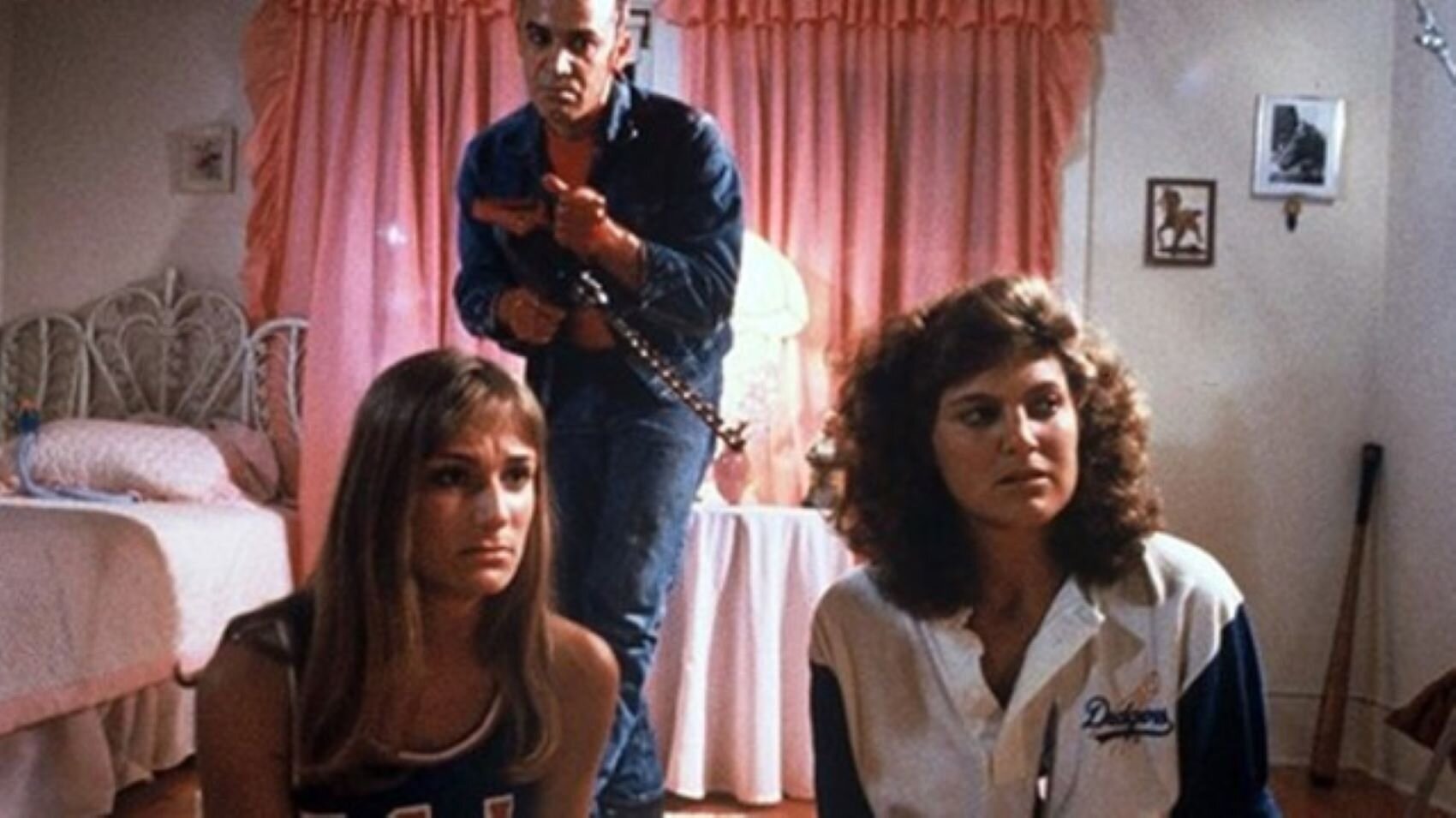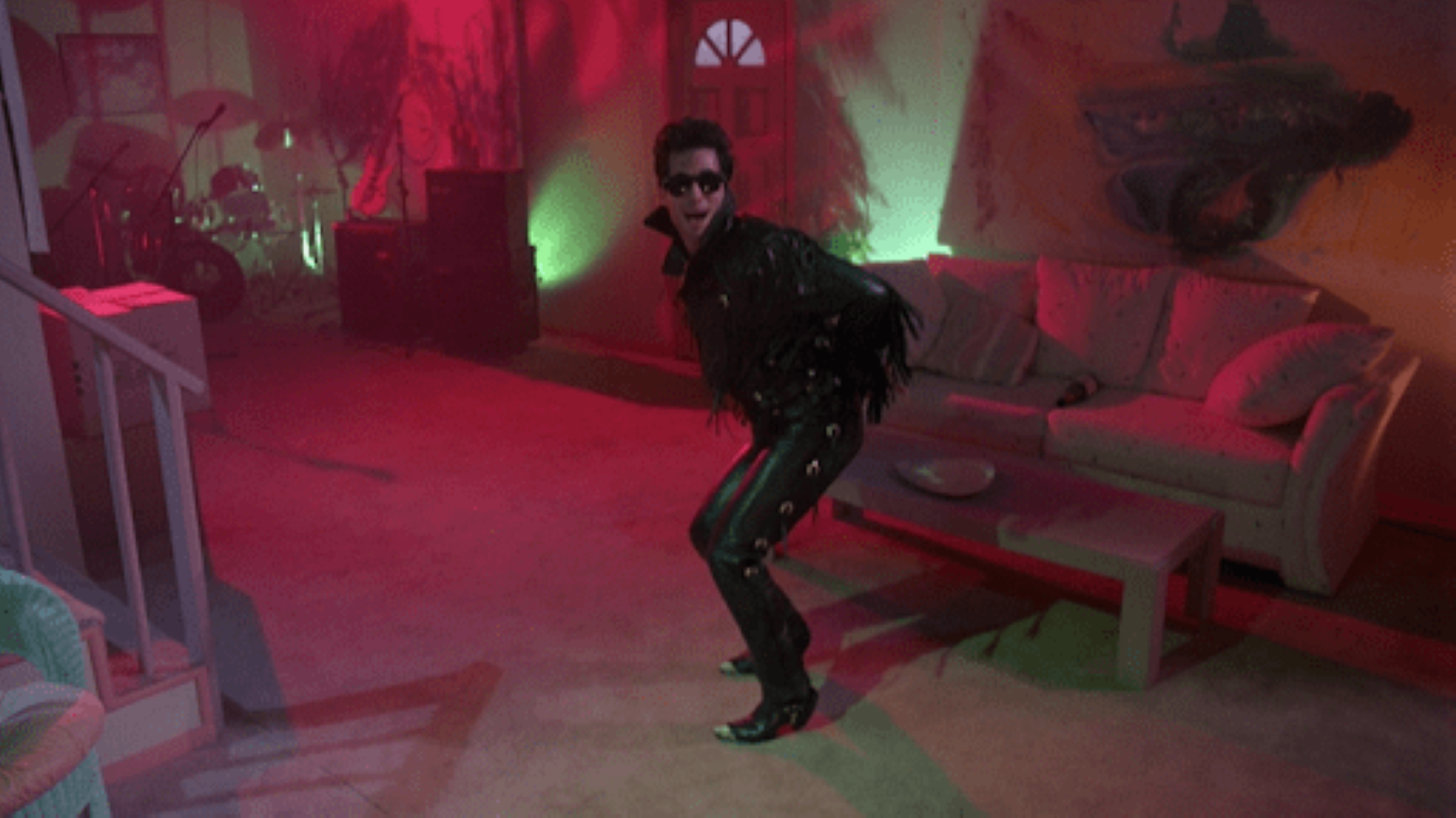[Editorial] Feminism in The Slumber Party Massacre Series, Part 2: From the Party to the Massacre
This piece contains spoilers for The Slumberparty Massacre (1982), Slumber Party Massacre II (1987), and Slumber Party Massacre III (1990).
In part one, I highlighted the themes present throughout the series that prop up the feminist messages: close female friendships, relaxing and playing together, women owning their sexuality, women’s comfort with their bodies, and of course a killer with a phallic symbol. Here in part two, we look at each movie in turn, and how the plot lends to the overall themes of the trilogy.
The Slumberparty Massacre (1982)
The first film has the most examples in the series of pro-woman messages. You can almost run a reverse-Bechdel test, because the women talk to each other about a variety of topics but the men pretty much only talk to each other about women. Women do talk to each other about men and sex, but they are talking about what they want, instead of what men want from them. There is a surprising scene where young women are seen enjoying a sexy magazine. Valerie catches her younger sister Courtney reading Playgirl, and Courtney jokingly says she’s “doing her biology homework.”
The women are athletes. They talk about sports, and when they can’t remember a play from the baseball game the previous night, they call their female coach for help. The men watch the women play basketball, taking a passive role to the women’s active role. At one point, John sneaks up on Diane, just to play a prank, and she easily tosses him. When the men are thinking about sneaking into their party, one says of the women “they could beat the shit out of us, we flunked gym.” It’s exceptional to see women portrayed as the strongest gender for the whole film, and not just in a Final Girl sequence.
While the final girl trope does play out, there are surprising twists. The men are just as afraid as the women, and no one seems like a superhero defending themselves. The Final Girl, Valerie, is the girl who didn’t drink or party, so that trope is as expected, but she has help from her sister Courtney and her neighbor Trish. Valerie chops the drill bit with a machete, emasculating the killer, just as Carol Clover describes in her seminal book on The Final Girl, Men, Women, and Chainsaws (1992). Three women ensure the killer’s death together, and the movie ends with them crying in fear and grief. This image of women fighting together, protecting each other, and allowing themselves to feel their emotions is unheard of in other slasher film endings. It sends a message that women can help each other and save themselves.
Slumber Party Massacre II (1987)
The second installment is similar to the first in its sex-positive and snack-positive vibe. Though it’s considered the “silly fun one” of the trilogy, it has some serious moments and feminist assertions. This story follows Courtney, the pre-teen sister from the first movie, and her mother a few years after the events of SPM1. Valerie, the first film’s final girl, has been in a mental hospital since the end of the last story, and their mother is raising Courtney alone. They are traumatized but trying their best to move on. The highlighting of a loving and strong single mother is uncommon in a slasher film. Her daughters have considerably different needs, and she is trying to balance them. For example, she suggests going to visit Valerie on an upcoming weekend, and Courtney begins to cry because that weekend is her birthday. Her mother is understanding, and says they can visit the psychiatric hospital another day. That’s a hard role for any parent to play, and the film shows a single mother in a positive light.
While the first film contained a group of athletes, the bonding activity in this film involves the friends being in a band together. They are talented musicians and are shown working on their music in their downtime, daydreaming about becoming famous performers. Similar to the first movie, they invite their love interests to watch them practice. Once again, the women are in an active role while the men are in a passive role. The film also highlights the women’s academic strengths. On the drive to their slumber party weekend at a vacation home, the women are discussing which colleges they would like to attend, which is an unheard-of conversation for women in an ‘80s slasher.
Sally is shown reading a book she stole from her brother called “Hot, Wet, and Wild.” Throughout the slumber party, the book is enjoyed by women and men together, in a positive portrayal of erotic fiction and its value to women. During the obligatory sexy pillow fight scene, when the men are peeping in the window, TJ says, “I didn’t know girls really did this stuff.” I laughed out loud at that line because I get the sense that it was written by Deborah Navarra-Brock (who wrote and directed) in response to a highly unrealistic scene produced by men.
Though the ending of the second film gets a little silly, this film is another example of a group of women who support each other, have goals, and enjoy being themselves. The feminist message persists around the phantom killer with the electric guitar drill.
Slumber Party Massacre III (1990)
The final film of the trilogy, this one is the most typical slasher, and offers less character development and less interesting dialogue. There is no activity, such as sports or music, that is the foundation of the friend group, but they are clearly close friends. Similar to the first two movies, the women are openly interested in sex, and even the “virginal” Final Girl Jackie mentions she has a diaphragm. There’s a notably sex-positive scene when a man goes down on a woman and expects nothing in return. This group of women is not shy about drinking and enjoying food, and my favorite line from the movie is “Here’s to beer bellies...and beer thighs!”
Where this film is unique from its predecessors, it offers a direct look at some of the dangers that women face. While peeping in windows was seen as cheeky, boyish behavior in the first two films, now looking in windows is portrayed as scary, as Jackie’s neighbor peers in with a telescope. The killer is revealed to be one Ken, of the guys at the party that night. The audience can infer through barely coherent shouting, newspaper clippings, and photographs that Ken was sexually abused by his uncle Billy, a police officer who killed himself. Ken has finally snapped and is drilling everyone to death.
This motivation is new for a Slumber Party Massacre movie. The killer is someone the women were friends with or even romantically involved with. We get a much deeper look into his mind, as he is recalling the abuse while threatening the partygoers. Maria, in an attempt at survival, begins to plead and bargain with the killer. She uses a soothing voice to talk to him about the bad things he has been through, and how hard it must be for him. Then she assures him he can do “whatever he wants” to her if she gets to live. He kisses and fondles her before snapping again, and Maria does not get to live. In a shorter but equally shocking moment, the killer yells “you’re not being very nice” before killing Janine. As a woman, being perceived by a man as “not nice” is apparently a capital offense.
I think of the first two movies as fun, silly comfort slashers, but surprisingly, the third one made my chest tight with anxiety. The deaths of Maria and Janine felt too real, too familiar. Bargaining with an abuser to change their behavior, even for a short time, is a survival skill none of us want to use, but many of us have. It’s horrible that Ken was abused by his uncle, and I wish he would have had the proper treatment to move past his trauma. But stories of women dying because men are angry and sad is too close for comfort in 2021. If the first two films celebrate things women can do and enjoy, the third is a warning to women: you can do everything right and still be in danger if an abuser puts you in his sights. Though this movie takes a darker turn with its more realistic twist, it fits with the feminist message of the other two. It told women to watch out and keep themselves safe, but also suggested that women could survive, much in the way that many Final Girls stories send that message.
Final (Girl) Thoughts...
The Slumber Party Massacre series should not be dismissed as a drop in the ocean of ‘80s and ‘90s slashers with nothing to say. Each film has several examples of feminist and pro-woman messages, and the series as a whole sends the same message. All three films, written and directed by women, are powerful examples of the difference it can make to have diversity in filmmaking. Enjoy these films as the fun slashers they are, but next time you watch, look for the uniqueness in them.





![[Editorial] 5 Slasher Short Horror Films](https://images.squarespace-cdn.com/content/v1/5fe76a518d20536a3fbd7246/1696358009946-N8MEV989O1PAHUYYMAWK/Screenshot+2023-10-03+at+19.33.19.png)
![[Ghouls Podcast] Maniac (2012) with Zoë Rose Smith and Iona Smith](https://images.squarespace-cdn.com/content/v1/5fe76a518d20536a3fbd7246/1696356006789-NYTG9N3IXCW9ZTIJPLX2/maniac.jpg)
![[Editorial] If Looks Could Kill: Tom Savini’s Practical Effects in Maniac (1980)](https://images.squarespace-cdn.com/content/v1/5fe76a518d20536a3fbd7246/1694952175495-WTKWRE3TYDARDJCJBO9V/Screenshot+2023-09-17+at+12.57.55.png)
![[Editorial] Deeper Cuts: 13 Non-Typical Slashers](https://images.squarespace-cdn.com/content/v1/5fe76a518d20536a3fbd7246/1694951568990-C37K3Z3TZ5SZFIF7GCGY/Curtains-1983-Lesleh-Donaldson.jpg)
![[Editorial] Editor’s Note: Making a slash back into September](https://images.squarespace-cdn.com/content/v1/5fe76a518d20536a3fbd7246/1694354202849-UZE538XIF4KW0KHCNTWS/MV5BMTk0NTk2Mzg1Ml5BMl5BanBnXkFtZTcwMDU2NTA4Nw%40%40._V1_.jpg)
![[Editorial] 8 Mind Horror Short films](https://images.squarespace-cdn.com/content/v1/5fe76a518d20536a3fbd7246/1693504844681-VPU4QKVYC159AA81EPOW/Screenshot+2023-08-31+at+19.00.36.png)
![[Editorial] Eat Shit and Die: Watching The Human Centipede (2009) in Post-Roe America ](https://images.squarespace-cdn.com/content/v1/5fe76a518d20536a3fbd7246/1691245606758-4W9NZWE9VZPRV697KH5U/human_centipede_first_sequence.original.jpg)
![[Editorial] Top 15 Female-Focused Mind Horror Films](https://images.squarespace-cdn.com/content/v1/5fe76a518d20536a3fbd7246/1691247166903-S47IBEG7M69QXXGDCJBO/Image+5.jpg)
![[Editorial] 8 Body Horror Short films](https://images.squarespace-cdn.com/content/v1/5fe76a518d20536a3fbd7246/1690838270920-HWA5RSA57QYXJ5Y8RT2X/Screenshot+2023-07-31+at+22.16.28.png)
![[Editorial] Metal Heart: Body Dysmorphia As A Battle Ground In Tetsuo: The Iron Man (1989)](https://images.squarespace-cdn.com/content/v1/5fe76a518d20536a3fbd7246/1690190127461-X6NOJRAALKNRZY689B1K/Screenshot+2023-07-24+at+10.08.27.png)
![[Editorial] Top 15 Female-Focused Body Horror Films](https://images.squarespace-cdn.com/content/v1/5fe76a518d20536a3fbd7246/1689081174887-XXNGKBISKLR0QR2HDPA7/download.jpeg)

![[Editorial] In Her Eyes: Tasya Vos in Possessor (2020)](https://images.squarespace-cdn.com/content/v1/5fe76a518d20536a3fbd7246/1667061747115-NTIJ7V5H2ULIEIF32GD0/Image+1+%285%29.jpg)
![[Editorial] In Her Eyes: Sara Lowes in Witchfinder General (1968)](https://images.squarespace-cdn.com/content/v1/5fe76a518d20536a3fbd7246/1655655953171-8K41IZ1LXSR2YMKD7DW6/hilary-heath.jpeg)
![[Editorial] The Babadook (2014)](https://images.squarespace-cdn.com/content/v1/5fe76a518d20536a3fbd7246/1651937631847-KR77SQHST1EJO2729G7A/Image+1.jpg)
![[Editorial] In Her Eyes: Helen Lyle in Candyman (1992)](https://images.squarespace-cdn.com/content/v1/5fe76a518d20536a3fbd7246/1649586854587-DSTKM28SSHB821NEY7AT/image1.jpg)
![[Editorial] Lorraine Warren’s Clairvoyant Gift](https://images.squarespace-cdn.com/content/v1/5fe76a518d20536a3fbd7246/1648576580495-0O40265VK7RN03R515UO/Image+1+%281%29.jpg)
![[Editorial] Sara in Creep 2 (2017)](https://images.squarespace-cdn.com/content/v1/5fe76a518d20536a3fbd7246/1646478850646-1LMY555QYGCM1GEXPZYM/27ebc013-d50a-4b5c-ad9c-8f8a9d07dc93.jpg)
![[Editorial] Sally Hardesty in The Texas Chainsaw Massacre (1974)](https://images.squarespace-cdn.com/content/v1/5fe76a518d20536a3fbd7246/1637247162929-519YCRBQL6LWXXAS8293/the-texas-chainsaw-final-girl-1626988801.jpeg)
![[Editorial] Margaret Robinson: Hammer’s Puppeteer](https://images.squarespace-cdn.com/content/v1/5fe76a518d20536a3fbd7246/1630075489815-33JJN9LSGGKSQ68IGJ9H/MV5BMjAxMDcwNDI2Nl5BMl5BanBnXkFtZTcwOTMxODgzMQ%40%40._V1_.jpg)
![[Editorial] Re-assessing The Exorcist: Religion, Abuse, and The Rise of the Feminist Mother.](https://images.squarespace-cdn.com/content/v1/5fe76a518d20536a3fbd7246/1629995626135-T5K61DZVA1WN50K8ULID/image2.jpg)
![[Editorial] Unravelling Mitzi Peirone’s Braid (2018)](https://images.squarespace-cdn.com/content/v1/5fe76a518d20536a3fbd7246/1628359114427-5V6LFNRNV6SD81PUDQJZ/4.jpg)
![[Editorial] American Psycho (2000)](https://images.squarespace-cdn.com/content/v1/5fe76a518d20536a3fbd7246/1627317891364-H9UTOP2DCGREDKOO7BYY/american-psycho-bale-1170x585.jpg)






















![[Editorial] 10 Films & Events to Catch at Soho Horror Film Fest 2023](https://images.squarespace-cdn.com/content/v1/5fe76a518d20536a3fbd7246/1700819417135-299R7L4P0B676AD3RO1X/Screenshot+2023-11-24+at+09.41.52.png)
![[Editorial] 9 Horror Nintendo Switch Games To Play](https://images.squarespace-cdn.com/content/v1/5fe76a518d20536a3fbd7246/1697214470057-3XZXX8N4LYIMDFWS6Z3P/Screenshot+2023-10-13+at+17.20.13.png)
![[Mother of Fears] Mothering in Silence in A Quiet Place (2018)](https://images.squarespace-cdn.com/content/v1/5fe76a518d20536a3fbd7246/1696445921315-HZJ2DZYQIH6VVWXBO2YL/Screenshot+2023-10-04+at+19.52.29.png)
![[Editorial] 5 Female Focused Horror Book Recommendations](https://images.squarespace-cdn.com/content/v1/5fe76a518d20536a3fbd7246/1696441981361-52EQCTJ7AT2QF1927GM7/919xtm6d3fL._AC_UF894%2C1000_QL80_.jpg)
![[Editorial] 9 Best Slashers Released Within 10 Years of Scream (1996)](https://images.squarespace-cdn.com/content/v1/5fe76a518d20536a3fbd7246/1695478839037-LOFHGVM3H6BMSZW7G83M/Screenshot+2023-09-23+at+15.15.11.png)
![[Mother of Fears] Mother Vs. Monster in Silent Hill (2006)](https://images.squarespace-cdn.com/content/v1/5fe76a518d20536a3fbd7246/1695485781119-H6GNP0G3J2TLPAOIABV7/Screenshot+2023-09-23+at+17.11.56.png)
![[Editorial] 9 Terrifying Cerebral Visions in Horror Movies](https://images.squarespace-cdn.com/content/v1/5fe76a518d20536a3fbd7246/1693509801235-X23OL50T1DVGECH0ZJK2/MV5BMjQ0MTg2MjQ4MV5BMl5BanBnXkFtZTgwMTU3NDgxMTI%40._V1_.jpg)
![[Mother of Fears] I Don’t Wanna Be Buried in a Pet Sematary (1989) and (2019)](https://images.squarespace-cdn.com/content/v1/5fe76a518d20536a3fbd7246/1691328766069-QFNAVJOMFZVZ5CLU1RWM/Screenshot+2023-08-06+at+14.23.13.png)

I can sometimes go months without having a panic attack. Unfortunately, this means that when they do happen, they often feel like they come out of nowhere. They can come on so fast and hard it’s like being hit by a bus, my breath escapes my body, and I can’t get it back.